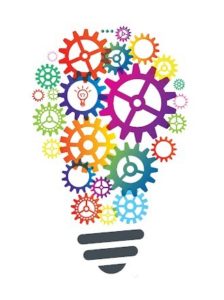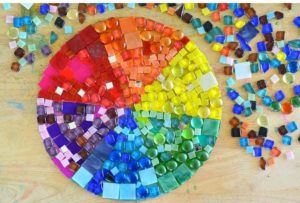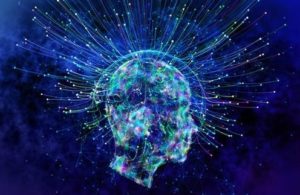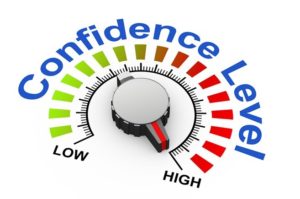English physicist and mathematician Sir Isaac Newton contradicted the ancient Greeks’ ideas about light by demonstrating that sunlight consists of a spectrum of colors. Newton realized that the earliest telescopes, in which glass lenses were fixed in a tube, distorted colors as the lenses broke the white light of bright astronomical objects into a rainbow. He constructed a new reflecting telescope that used mirrors instead of lenses to focus the light. Newton’s innovative approach was made possible by his ability to see conventional ideas from a different angle.
New and original solutions to the same old problems lead to more effective decision making—greater choices among alternative sequences of actions and inaction. Seeing the world in a novel way leads to innovation and change. And a willingness to embrace change is necessary if one is to examine predetermined conditions and boost innovation. It is natural human tendency to perceive as a threat change, which is associated with the destruction of established patterns of thinking and fear of failure. Resisting change is often followed by countless justifications as to why no changes were made. Welcoming change, on the other hand, opens the door to the very fluency, originality, flexibility, elaboration, and ability to postpone premature closure that are needed for creative problem solving—which is a driving force behind improvement in any area of life. These major characteristics of creative thinking produce a “survival kit” in a complex environment. Enabling fluency, flexibility, and originality while postponing premature closure leads to self-empowerment and a concomitant greater chance of succeeding.
The link between the five major characteristics of creativity—fluency, originality, flexibility, elaboration, and postponed premature closure—can be outlined as follows:
- Creative thinking is defined by the postponed closure of flexible combinations among fluent thoughts with original interpretations of the interconnections among elaborated details defines.
- Fluency—the ability to generate multiple responses, ideas, and alternatives—increases the potential connections among various selections and, subsequently, the likelihood that one of these ideas will be developed into a great invention. Fluency additionally refers to an aptitude for expressing ideas simply and coherently.
- Originality is essentially a trend of being able to generate unexpected responses to a challenge; it increases the possibility of novelty. Originality prevents reproductions, imitations, and cliches.
- Flexibility entails looking at the same problem from different perspectives, which permits new connections and unexpected combinations. Flexible associations increase the likelihood for coming up with novel and successful combinations.
- Elaboration is the ability to expand and improve ideas through embellishing their details. This personality trend assists in forming more flawless, precise, and pleasing ideas with better logic and more in-depth analysis. Elaboration results in amplifying the initial idea and moving it toward enhancement and implementation.
- Suspending premature judgment or criticism effectively delays the disapproval of new thoughts and thus prevents the reduction of possible ideas and their combinations.
There are various techniques for enabling major characteristics of creativity, nurturing that creativity, boosting innovative problem solving, and make improvements in the overall quality of life.
Creative thinking results from a complex amalgamation of different characteristics that allow the mind to think in different directions and entertain alternative solutions. During the training and workshops on creative decision making I’ve presented for licensed administrators in NYC, I have asked my participants to practice fluent thinking by creating as many ideas as possible in a short period of time. My students have generated ideas for how to utilize familiar items—such as cups, scissors, and paperclips—in a novel way. They’ve additionally drawn pictures representing new designs for their houses and apartments, thought up alternative titles for their favorite books and songs, rewritten the epilogues of famous movies, and generated solutions to various issues, such as budget cuts and even global warming. Sometimes these exercises involved thinking of new ways to host a party or cook unusual dishes. Having as many ideas as possible and easily drifting among them prompts a novel viewpoint. Fluency refers to both the quantity and flow of generated thoughts and associations among them.
As it involves flexibly shifting one’s thoughts from one area to another, fluent thinking allows the development of unique ideas. Fluency boosts metaphorical and symbolical thinking, because the informal associations it encourages easily form new expressions and restructure pre-consumed notions. Fluent thinking furthermore allows one to tolerate semi structured concepts and uncertain notions, which is important—combining incomplete thoughts may form unexpected ideas. The novel combinations and surprising reasoning inherent in fluent thinking open into new experiences.
Unique ideas are not always immediately valued. One’s organization of thoughts along with reasoning, clarification, and objective evaluation can all help in determining the value of the final products of ideational fluency. This type of fluency within one category is not essential for creative thinking on whole, as creative thinking involves free associations among different categories. Alternative expressions of the same notion through a different categorical entity may enrich and even modify the expected outcome. Converting information into a new structure or explaining a problem in terms of a different conceptual category can open the way to more responses and solutions. The process of shifting from one idea to another, as in ideational fluency, is analogous to a very simply mathematical equation: Cause 1 + Cause 2 = Effect 1. The combination to two different ideas (causes) amalgamates into a new idea (effect).

Via fluency, dogmas can be adjusted and improved as they are tested in a different area and reexamined. An old idea may be expended or at least re-branded after probation in a different structure. Our explanatory capacity grows as we are able to apply the standard qualities and terminology of one domain to another—explaining music through mathematics, science through art, and so on. Associations between noticeably different categories result in approaches that are more original and a greater number of responses.
Originality applies to being fresh and independent of pre-consumed dogmas, and to having imagination, independent thought, and the ability to combine thoughts. While originality is generally thought of as an occurrence or as a process—of prompting new ideas—it can also be defined as interpretation or combination. Original ideas do not necessary have to be useful; they must, however, defer from existing concepts.
We’ve all experienced moments when an exciting idea starts to flourish, but our inner critic discourages us from pursuing it by saying the idea won’t work or isn’t worth the effort. A key component of the creative problem-solving process is the postponement of preliminary judgement. The initial signs and symptoms of new idea are usually elusive. During the stages of idea formation and the generation of possible solutions, positive and negative judgment should be avoided. Since quantity of ideas is able to raise their quality, enabling multiple combinations and evaluations, no options should be restricted or postponed. The oddest combinations between meaningless choices may lead to the most unusual and valuable ideas. Going beyond typical reflection and suspending the verdict will allow more flexible association and combinations among them.
Observation of and reflection upon the actual processes involved in creative thinking can help avoid one avoid closure before all the possibilities have been explored and understood. Thinking from different points of view, being spontaneous, tolerating ambiguity, and making unexpected connections will most likely result in a novel format of thinking. Experimenting, reflecting upon contradictions, and determining the relevance of certain ideas leads to a feeling of discovery and increases the likelihood of novel decisions. Original thoughts are highly valuable as long as they can transform into valuable inventions. The ability to think of fresh ideas, fall in love with those same ideas, and make meaningful patterns of original ideas require decreased premature filtering along with increased recognition of the creative process.

Premature closure is not the solution. When original ideas travel from the point of inception to the point of implementation, they are filtering through the logical reasoning and judgment. At this point, it’s important to use “indulgent” critique so as not to suppress valuable points, which may not be fully developed yet. Since this process may involve ambiguity and metaphorical paradoxes, it’s essential to go above and beyond the right choice and consider approximate exacts. It is also important to be able to bend the rules, take risks, and expend boundaries without jumping to conclusions.
Flexibility provides various possibilities and wide ranges of conflicting ideas. It helps when it comes to dealing with stressful situations and failures, bending cliches, and changing the rules. Greater freedom among choices strengthens several important categories, including self-regulation, independent thinking, and self-empowerment. It additionally promotes open dialogues and a constant search for alternatives. Easily shifting in thought to a contradicting direction, or flipping to an opposing argument, results in a stronger reasoning. Having a flexible approach to the different angles of a given matter assists one in creating a holistic perspective and deeper understanding of the phenomenon. Adopting new ways of thinking is assisted by a creative and logical analysis of multiple possibilities. An easy adjustment to a new structure welcomes new ideas and increases engagement. Stepping out of one’s comfort zone may result in not only the improved acquisition of information but also practice in pushing boundaries and extending behavioral space and performance. A playful approach to reorganizing ideas minimizes stress and negativity. Engaging in flexible decision making can preclude the restrictions and prejudgment that tend to block great ideas from developing. Flexibility doesn’t mean chaos. It requires planning and organization to experience the meaningful shift of perspectives, along with reflection on the best solutions.
Elaboration identifies a process of amplifying an original idea from basic to more advanced. Adding more definitive characteristics and details increases the likelihood of successfully generating ideas. To improve the mind’s elaboration capacity, one should practice offering as many characteristics of the subject or condition as possible. An original idea can be expanded by adding multiple details, perfecting its associations by dwelling on its complexity and looking for multiple connections, and by identifying more details yet and surrounding conditions. Amplifying once-simple thoughts via scrutiny of one’s inferences and the addition of new points-of-view to existing ones, people create stronger attitude and self-confidence. A variety of cues and processed thoughts may result in a greater assertiveness pertaining to the problem. Given that opinion formation and conscious judgment arise from the thoughtful consideration of multiple details based on collected information and conceptual redefinition, elaboration plays an important role in improving cherished ideas.
The overprotective inner critic constructs creativity blocks, endorses inaccurate results, and boosts incomplete assumptions.
Creativity is a habit of the mind. Characteristics of creativity can be learned and adopted through continuous practice and exercise. To enable fluency, flexibility, originality, and the avoidance of premature closure, it is essential to associate these personality trends with particular means, thoughts, or actions. Thus, fluency is associated with an ability to quickly create sequences of ideas, meanings, arguments, or expressions in relation to a certain entity or situation. To enable fluency, it is essential to practice fast responses, produce ideas even when they are contested, self-monitor, improve working memory, generate strategies, freely reason, and practice thinking of conflicting possibilities. These sub-characteristics of ideational fluency can be promoted by exercises such as identifying problems in structures or products, linking as many objects and conditions as possible, and finding as many synonyms as possible. During my presentations on creative thinking, I usually ask my participants to write a sentence using specific words, name an object based its characteristics as quickly as possible, and create as many ideas that are statistically contradictory as possible. Exercises based on producing multiple ideas to meet certain goals and creating multiple associations among irrelevant objects can be fun and effective ways to improve ideational fluency.

Originality can be improved through forming contradictory ideas and combining them with conventional statements. Forming unexpected associations between distant matters, relabeling objects, and redefining generally approved statements endorse original thoughts. Flexibility can be developed through bending rules and creating new ones, both in writing and in drawing. It can be furthermore boosted by adopting new patterns of thinking, walking, eating, etc. Producing a great variety of ideas within or outside of the defined margins increases the ability to generate unusual thoughts.
The potential-extending process of elaboration can be promoted by engaging in sufficient analysis and exercises in which details related to the primary-topic details are found. Finding supporting content and scrutinizing distinctive characteristics from various points of view contribute to increased elaboration ability. Expanding basic ideas and creating as many possible distinctive cues as possible enhance the capacity to elaborate. “Zooming in” on every single detail through the lenses of scrutiny, comparison, and contrast subsidize general ideas and causal relationships between them. This process advances, refines, completes, and clarifies basic thoughts and improves concepts.
To improve the capacity for postponing preliminary judgment, create as many free associations as possible—and don’t over-analyze them. Remain open to any ideas. Preliminary judgment restrains the exploratory process and minimizes the chance for experiencing new thoughts. Looking at a conventional postulate from an unexpected angle will aid the mind in postponing preliminary closure. For instance, you could gain a new perspective on a movie you don’t like by making a list of reasons why you don’t favor it and then writing the contradictory statements across every negative reason. Striving for a higher number of remote ideas and unexpected connections among them with reserved evaluations and postponed criticism allows creative ideas to fully elaborate and reach their peak. The evaluation process should start only after the idea has been fully elaborated.
Established characteristics of creative thinking—including fluency, originality, flexibility, elaboration, and postponed judgment—stimulate self-improvement from the perspectives of motivation, confidence, and productivity. These personality trends result in continuous personal development and dynamic minds that never stop challenging status quo. Being creative means feeling deeply and concentrating exhaustively, being sensitive and seeing inspiration in everything, taking risks and getting bored with routines. Creativity is the greatest and most valuable trend of the mind; it allows people to invent, imagine, and successfully solve problems. Creativity improves self-esteem and motivation. It doesn’t simply increase achievement; it makes people more open to more challenges in which achievement is a potential endpoint. Fluency, originality, flexibility, elaboration, and postponed judgment help in problem solving across all aspects of life while extending one’s means of self-expression and leading toward mastery. Creativity additionally hones sensitivity to problems, deficiencies, and gaps. It helps in both detecting missing particles and searching for solutions. When improving characteristics of creativity, we reduce causes of stress that trigger aggressive behaviors and nervous breaks. Creative trends help us channel anger into passion and they boost our confidence.

Creative thinking assists in the process of restructuring perspectives and producing unexpected combinations. Creative thinking allows us to connect pieces of information into meaningful and unexpected patterns—a critical ability when you consider that we perceive the world around us based on our interpretation of patterns. Creativity is a meaningful modification based on the new patterns of meaning. When we are creative, we feel we are living more fully.
Creativity enhances the quality of solutions to life’s problems and it, better than even intelligence, predicts life achievements. Creative people can adapt to different situations and reach their goals. To improve creativity, in general, and its characteristics, in particular, it is essential to display interest, think new thoughts, open up to experiences, imagine, take risks, and ignore distractions. It is also feasible to set clear goals. Making unusual connections, forming opinions, putting ideas into practice, and classifying information are the powerful tools for successful decision making. Comparing and contrasting, postponing evaluation, and adapting new attention patterns promote creative outcomes. Besides personality characteristics, social environment is important because it can either promote or confine personal tendencies. Using positive affirmation and balancing the inner self are effective practices for enhancing creative self. Establishing a harmonious environment, increasing performance standards, and improvising all promote major characteristics of creativity and increase the likelihood of success.